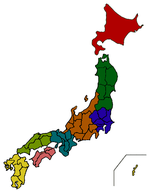Sumoto Castle
| Sumoto Castle | |
|---|---|
洲本城 | |
| Sumoto, Hyōgo, Japan | |
 Sumoto Castle | |
| Coordinates | 34°20′16″N 134°54′10″E / 34.33778°N 134.90278°E |
| Type | Yamajiro-style Japanese castle |
| Site information | |
| Condition | ruins |
| Site history | |
| Built | 1526 |
 | |


Sumoto Castle (洲本城, Sumoto-jō) was a Muromachi to Sengoku period Japanese castle located in the Orodani neighborhood of the city of Sumoto, Hyōgo Prefecture, Japan. Its ruins have been protected as a National Historic Site since 1999.[1] It was also referred to as Mikuma Castle (三熊城).
Overview
Sumoto Castle located on the southeast coast of Awaji Island on a long and narrow ridge of the 130-meter Mount Mikuma. Awaji Island has been a strategic transportation hub for the Kinai region since ancient times, forming part of the route between Honshu and Shikoku and controlling maritime transportation between the Pacific Ocean and the Seto Inland Sea and Osaka Bay. In the Sengoku period, the island was controlled by the Miyoshi clan, who ruled Sanuki, Awa and Kawachi Provinces. Sumoto Castle was constructed by their retainer, the Otaki clan, around 1526. The island was seized by Hashiba Hideyoshi in 1581 as part of Oda Nobunaga's conquest of western Japan, and assigned his general Sengoku Hidehisa to govern Sumoto. In 1583, Sengoku Hidehisa was officially named daimyō and he modernized the Sumoto fortifications, and used the castle as his residence. However, Hidehisa was defeated and disgraced in 1586 in a battle with the Shimazu clan in 1585 and was replaced a Sumoto by Wakizaka Yasuharu. With the support of Hideyoshi, Wakizaka Yasuharu expanded the castle to protect the seaward approaches to Osaka, the economic center of the Toyotomi government. [2]
After the 1600 Battle of Sekigahara, Awaji came briefly under the control of the Ikeda clan of Himeji Domain. The Ikeda clan abolished Sumoto Castle and built Yura Castle on the northern region of Awaji Island, which was closer to their stronghold at Himeji Castle. But after the Battle of Osaka from 1614 to 1615, Awaji was awarded by the Tokugawa shogunate to the Hachisuka clan of Tokushima Domain, who appointed their retainers, the Inada clan as a governors of Awaji. As Sumoto was closer to Tokushima than Yura, the Inaba rebuilt Sumoto Castle in the 1630s. Sumoto Castle was held by the Inada clan until the Meiji restoration of 1868. Nothing remains of the castle today except for some complex-shaped stone walls.[2] In 1928 the tenshu was rebuilt in reinforced concrete in commemoration of the enthronement of Emperor Hirohito.[3]
The upper castle was designated as a National Historic Site on January 14, 1999, and the lower castle was also designated as a historic site in Sumoto City. The Sumoto City Awaji Cultural History Museum, which displays materials related to the upper castle, is located on the site of the lower castle. Sumoto Castle was listed as one of the Continued Top 100 Japanese Castles in 2017.[4]
See also
Literature
- De Lange, William (2021). An Encyclopedia of Japanese Castles. Groningen: Toyo Press. pp. 600 pages. ISBN 978-9492722300.
References
- ^ "Ruins of Sumoto-jō". Cultural Heritage Online (in Japanese). Agency for Cultural Affairs. Retrieved 15 September 2021.
- ^ a b Isomura, Yukio; Sakai, Hideya (2012). (国指定史跡事典) National Historic Site Encyclopedia. 学生社. ISBN 978-4311750403.(in Japanese)
- ^ "Sumoto Castle - history". Sumoto Castle. Archived from the original on 8 February 2018. Retrieved 1 February 2012.
- ^ "続日本100名城" (in Japanese). 日本城郭協会. Archived from the original on 2 December 2019. Retrieved 25 July 2019.
External links
![]() Media related to Sumoto Castle at Wikimedia Commons
Media related to Sumoto Castle at Wikimedia Commons
- Sumoto Castle official homepage (in Japanese)



